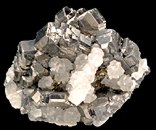|
|
| Formula: | CuPbSbS3 |  Click to see a larger image |
||
| Crystal: | Orthorhombic | |||
| Hardness: | 2.5-3 | |||
| Spec. Gr.: | 5.83 | |||
| Streak: | Steel gray to black | |||
| Cleavage: | 1 good, 2 fair | |||
| Location: | Liskeard, Cornwall, England |
| Bournonite was named after the French mineralogist and crystallographer Count J.L. de Bournone, who first determined the chemical composition in 1805. It is a hydrothermal ore mineral which contains forty-two percent lead, thirteen percent copper, and twenty four percent antimony. Large well-formed crystals were found at Liskeard, England; also at Pribram, Czechoslovakia; Neudorf and Andreasberg, Germany; and in Peru. Lustrous black bournonite crystals of good size and surrounded by white quartz crystals were the "trademark" of Liskeard, and are considered to be the world's finest. |
|
Bibliography: Svenek, Jaroslav. Minerals, 1987, pg. 82-83. |
|
University of California, Santa Barbara—Department of Earth Science Copyright © 2005 Regents of the University of California Send your comments to the Web Page Editor |